The "Rededication in 1947" Photo Album was first posted on July 18, 2010 into Picasa and has been viewed by 3,704 viewers around the world since this public posting. Google has just announced the removal of all Picasa Images and Albums later in 2016. I therefore, have saved all images, image data, and paragraphs as they were created several years earlier, and I will now rebuild this same content as Word Document pages in the months ahead. This content will now be here.
I thank you for your interest in this history over these many years, and I will work as diligently as I can in the months going forward to insure that these images and history will be available 24/7 in the years ahead. I will also try and correct any errors in the descriptions that may have come to light since the original "post-up" dates in all of my albums. I may also try to improve the quality of all photographs by using a cleaner version of the same image from my expanded collection of images here. Most of the text paragraphs should remain the same, how- ever, if significant new information becomes available, I will update these paragraphs in the re-posting of this album on my website.
The Author. (8-20-2016)
In these colored boxes Paul Kalotay is quoted with his personal recollections at these events.
I wish to thank Paul Kalotay, who was a young man at the time, and was heavily involved with the sound systems both at the cathedral and on the Főtér the following day at the Marian Celebrations. It is remarkable that Paul still remembers the events and some of the individuals that are pictured below, now some seventy years later.
Thank you Paul for your Hungarian Translations, your insights into this period and most of all, for your help over these many years in the understanding of these events in March 4, 1945.
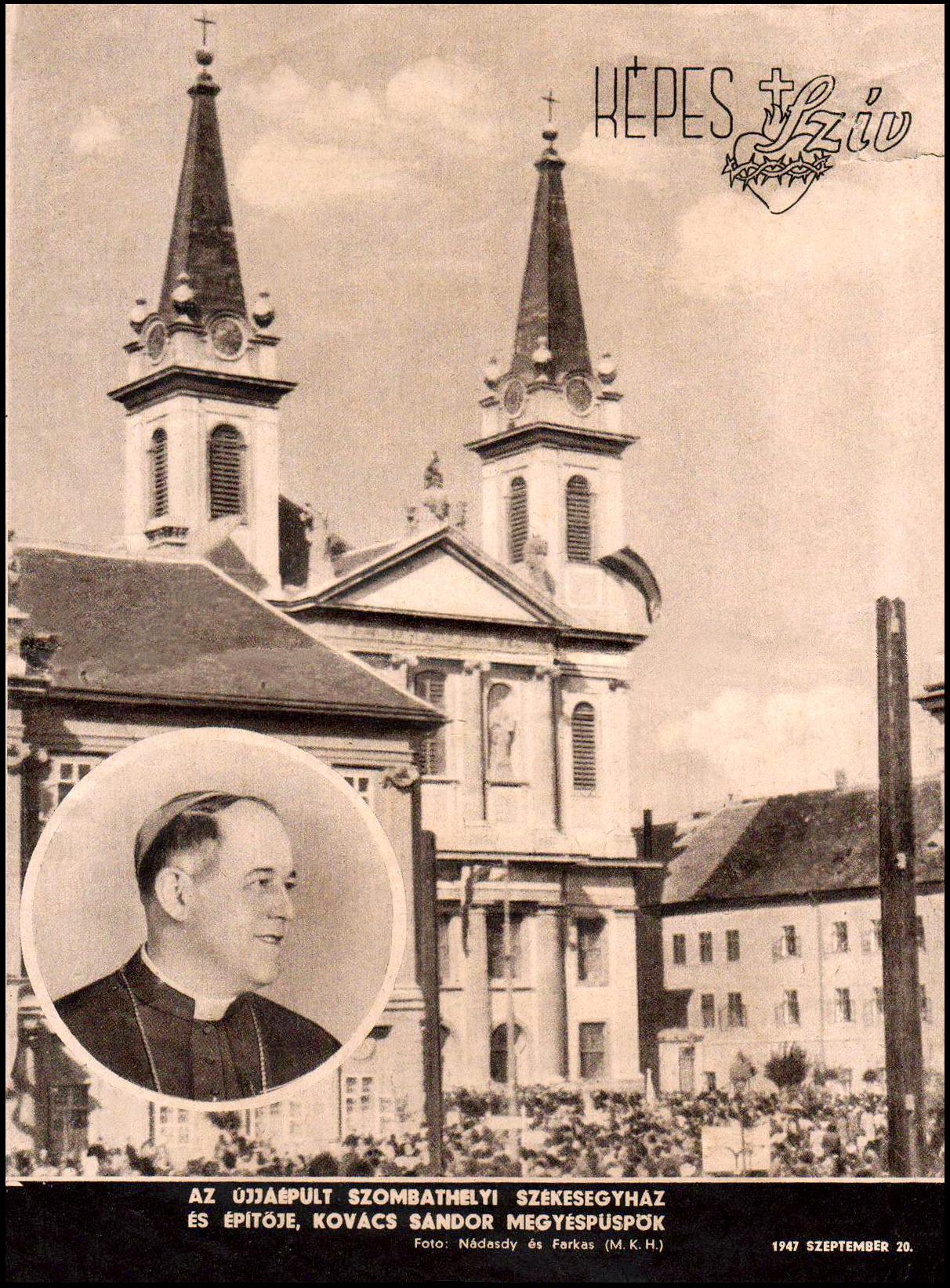
In the summer months ahead, I would like to add additional images to this album if possible. Should you have photographs from this period, please contact us at the Web Site e-mail address found on most pages in the March 4, 1945 Project Website. I am most interested in the period of March 4, 1945 - Sept. 8, 1947 the period of reconstruction, the rededication and the Marian Celebrations on this weekend in ‘47.
The above image is a single page from a magazine or newspaper dated 1947 Sept. 20. The title is: "The Heart". The Bishop's Palace, the Cathedral and Seminary with a photograph of Bishop Kovács Sándor.
Please note the two large black poles in the image above. One is at the right edge and the second is at the edge of the Bishop's Palace. In his book, Toronyi István wrote: “…that due to the presence of over 100,000 people in the city for the two day celebration, multiple altars were established outside the cathedral.” The service inside at the “High Altar” of the cathedral was then broadcast via wire to other locations in and round the city. The priests at these various sites presided with their actions at their Altars in coordinated unison on raised platforms, with each having large crowds in attendance. These temporary poles may have carried the wires for sound system to the remote locations within the city and for the priests and worshipers to hear the progress of the Mass as it was unfolding inside the cathedral.
Képes Szív was the title of a religious “sister” magazine publication of the “SZÍV” (Heart). The poles seen in this picture may or may not be the ones that served as loudspeaker-mounts. I do not recall any of them at the Cathedral. At the Főtér, we used the gas light’s iron posts for the loudspeaker mountings. Thinking back, I sort of recall that the loudspeakers at the cathedral may have been mounted on the building itself. We did not have unlimited cable supplies. The Főtér was “pre-wired”; and we only moved relatively few loudspeakers once the rededication was over, to the Főtér. –Paul Kalotay
The cathedral has often been referenced as having a capacity of 5,000 attendees, and this may have been from the fact that all worshipers inside the cathedral this day, were all standing (shoulder to shoulder) for the Re-dedication Service on this Sunday. In a later image of this album, you will see another of these poles at the platform for the Marian Celebrations on the Főtér of the following day. In picture #2 below, the lighting is early afternoon, and some of the buildings were still being repaired on the south side of the Főtér. Note the single pole with speakers attached.
Read the Toronyi book in both English or Hungarian on this Website: March 4, 1945 Project. Further information or images would be appreciated from Szombathely residents about these poles or activities on this day if known.
Credits for the following images: The Bishop's Archives, and Mr. László Földes of Szombathely. Note: many years have passed since the publishing of this paper, and the decay and foxing of the paper stock has necessitated some minor repairs. The center fold in image #5 was removed via Photoshop here.
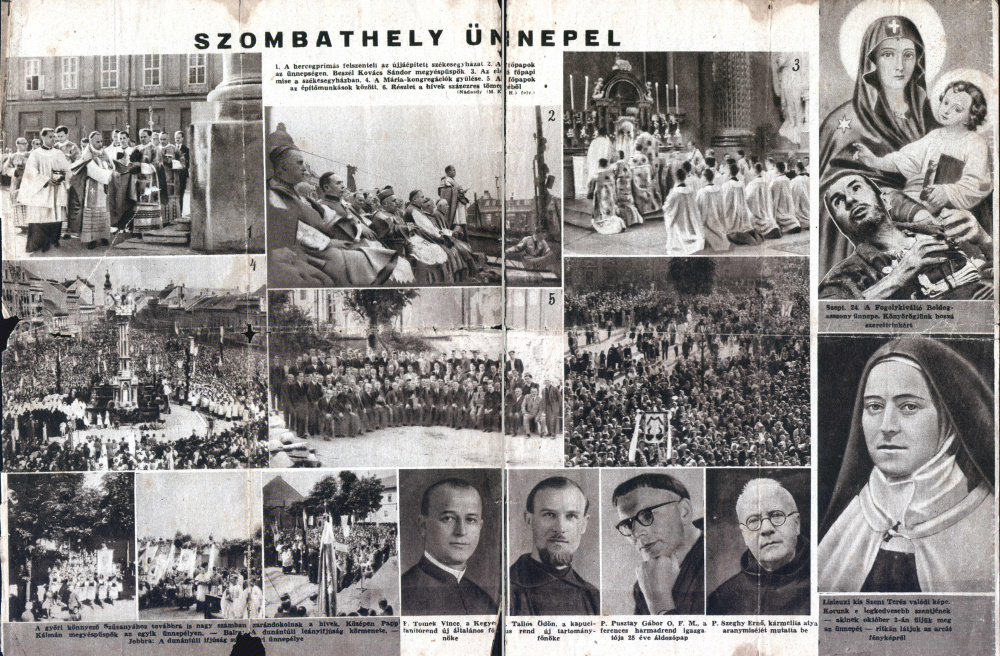
Some of the Images that were used in this paper above, will now be taken individually with comments added.
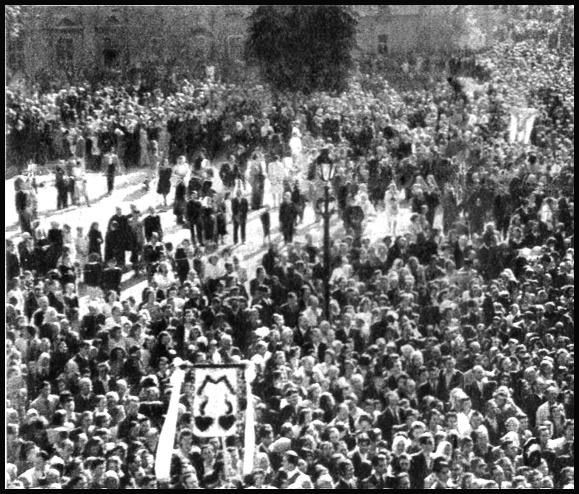
The parishioners from Szombathely and visitors are waiting outside the Cathedral for the doors to open. Shadow lines on the pavement would indicate 10-11 am. In this narrow view only, approximately 3,000 souls are waiting here on Sept. 7, 1947. This and the following images were taken from the above newspaper insert. I have adjusted the photographs that follow now, as all of them needed some repairs, cleanup, and enlargement from the newsprint original edition. The original photographs would probably have been held by the publisher in those days, but I am unable now to give credit to the photographer or right full holders in these modern times (advise if desired).
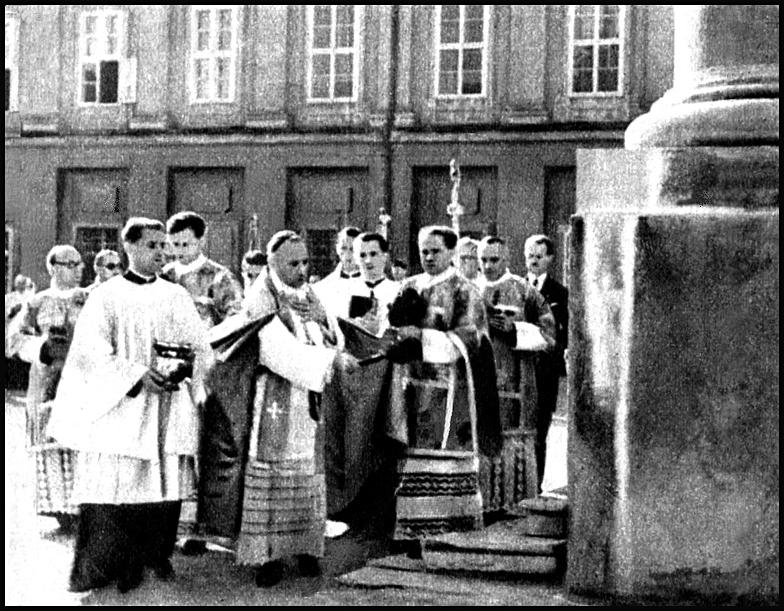
Directly behind the Primate the tall fellow seemingly reading is the Rev. Göndöcs László, a professor at the Seminary. Holding a book second at the left side of the Primate, is Prof. Joseph Winkler, a theologian from the Seminary. –Paul Kalotay
"..The Pilgrimage started in the early morning of September 7th. Parishes from around Szombathely and the Country arrived one by one, lead by their pastors. The first pilgrim train arrived from Zalaegerszeg, with extra cars and over 1,000 passengers. Continuing through out the early hours, additional long trains arrived with many more thousands of pilgrims to witness and to be a part of the glorious ceremony about to take place.
At 9 o'clock the ringing of bells signaled when the Cardinal Prince Primate and the Bishops leave the Bishop's Palace. Surpliced priests lined up in the square of the church. The Schola Cantorum Sabariensis was singing "Ecce sacerdos" in the choir loft of the closed cathedral. The Cardinal Prince Primate, accompanied by his close assistants, and started the moving ceremony for the atonement and re-dedication of the church.
After the introductory prayers he took the bundle of hyssop in his hands and sprinkled holy water on the outer walls of the cathedral. Meanwhile, seminarists were singing the psalm of repentance (Psalm 50): Purify me with hyssop, and I shall be clean: Wash me, and I shall be whiter than snow... Create in me a clean heart, O God... Cast me not away from thy presence; and take not thy Holy Spirit from me." (Toronyi István)
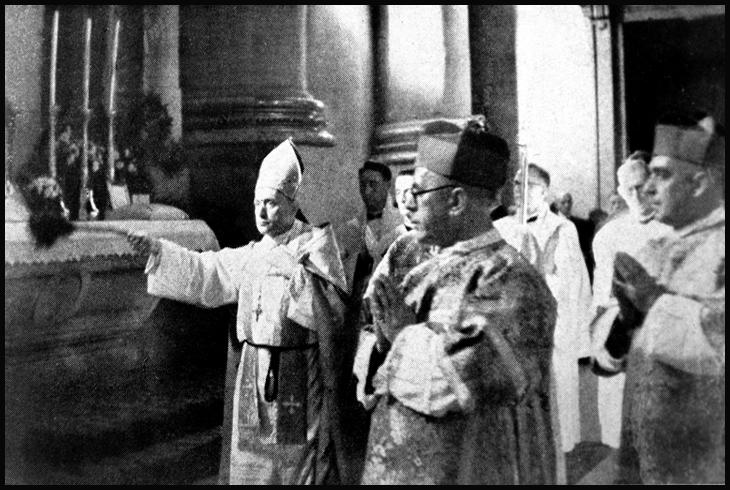
The image was taken in the South Transept with the doors to the Vestry at the right. The morning sun now radiates on the wall behind the party.
The second priest from the right edge in white “karing/surplice” is the Rev. Márton Róka. –Paul Kalotay
The Re-consecration of the Altars begins:
"...After the prayers the litany of All Saints was started, the gates of the cathedral were opened and Cardinal Mindszenty with his assistants entered the great Nave. The Cardinal approached the high altar and reconsecrated it with holy water using a bundle of hyssop. The crowd was standing in prayer on the cathedral square and on the streets around the church.
Every moment of the ceremony was broadcast through speakers for all the pilgrims outside to hear. ‘Be so kind to conciliate this church’ – came the sound from the speakers and thousands of people (waiting outside) now answered humbly: ‘Lord, hear our prayer.’ " (Toronyi István)
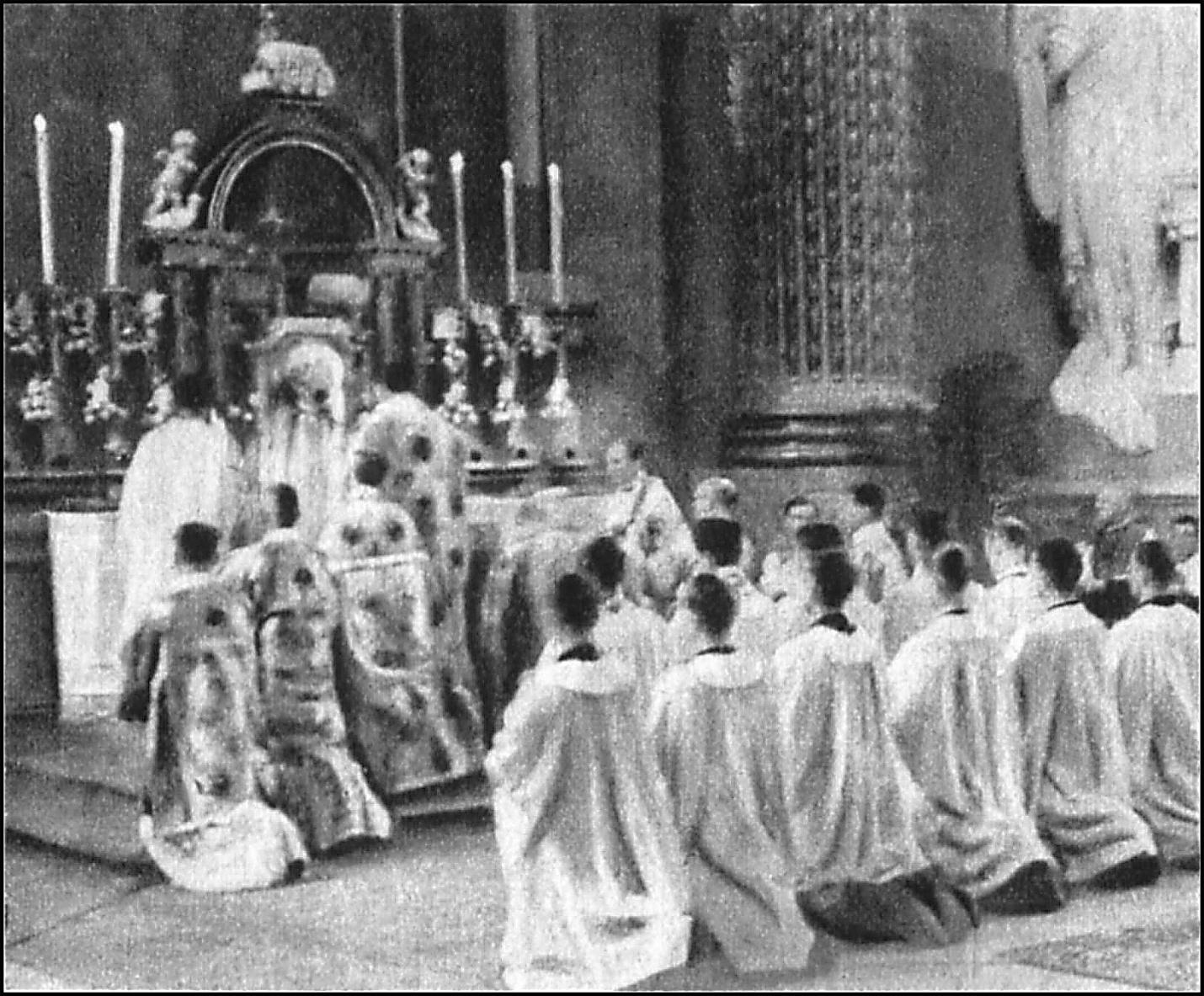
"… First, the builders stepped over the threshold of the cathedral and took their places in the Sanctuary. These workmen with steady labor made possible the Re-construction of the cathedral in two short years.
...The people then begin to stream into the cathedral in an orderly fashion. The Nave and Transepts were full, shoulder to shoulder, patiently standing for the beginning of the service. Even the six Side Altars areas were filled and it was estimated that there were 5,000 person now inside patiently waiting for the Mass to begin.
...Everyone is singing the hymn, ‘O Blessed Mother, the Patroness of our Country, the Patroness of our Diocese...’ When the singing stopped, the bells of the cathedral started ringing, as well as the bells of all the churches in Szombathely. The Bishop had instructed that at this very moment, every church in the Diocese should sound its bells, signifying the joy of the reconstructed cathedral and its reconsecration to the glory of God.
...In an instant, 350,000 people of the Diocese heard the bells ringing all at the same time. Cardinal Mindszenty, now vested, begins celebrating the first Holy Mass with great joy.
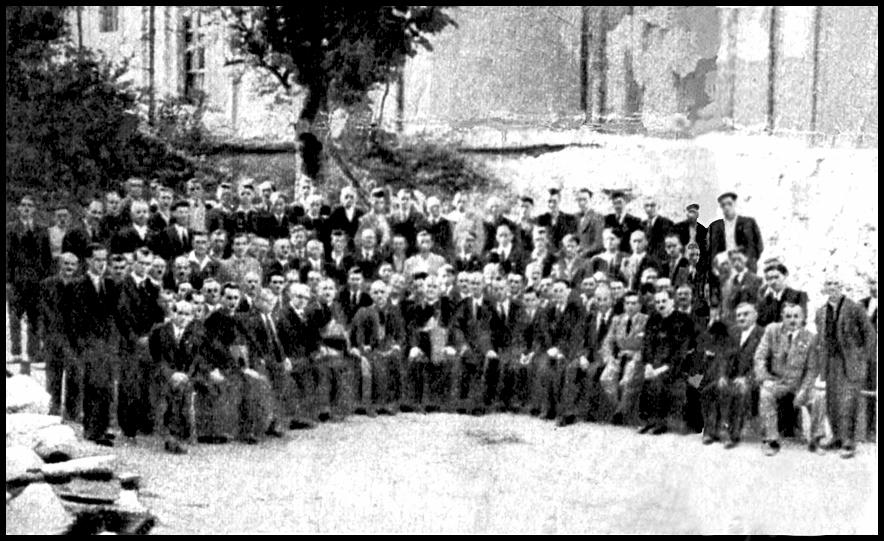
A rare photograph of the workmen who rebuilt the cathedral taken about the time of the dedication 1947. Bishop Kovács Sándor is seated in first row-center. The image was taken in the mid afternoon in the garden of the Bishop's Palace near the wall of the garden with the cathedral's south side just beyond.
"... First, the builders stepped over the threshold of the church and took their places in the Sanctuary. These workmen with steady labor made possible the reconstruction of the cathedral in two short years." (Toronyi István).
Photo credit: The Bishops Archives, Szombathely.
(To descendants of the workmen in Szombathely: I do not have names or information on the men above who gave so much through their never ending dedication to finish this great work. Any photographs from old family albums there, and/or a short biography of him, his family, or his work, would be welcomed by this author (for posting in a new album at a later date). I also have examples here, of “time sheets” from the period that may also have “listed” him, his hours, and payments and/or in equivalents other than money. (See our address on the "Szombathely Cathedral 1945 Project Website.”) Thank You. (9-20-2016)
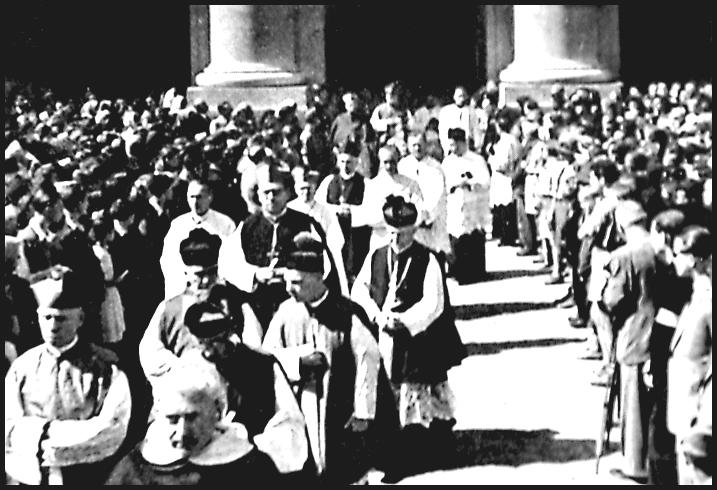
The procession out of the cathedral after the Re-dedication Service. September 7, 1947 (11:30-12:00 pm.)
The priest at the lower-left corner is Professor Dr. Rogács Ferenc from the Seminary next door. The priest at the center of the image with his head slightly bowed appears to be Dr. Géfin Gyula, and at his right, Bishop Kovács Sándor. –Paul Kalotay
The "Great Service" is now over and the Guest Clergy depart into the Cathedral Square. The density of the crowd would indicate that these souls were not able to gain access into the cathedral for the rededication program. Note the gentlemen at the right with his camera on a tripod perhaps waiting for the Cardinal to exit.
We know that there was an altar set up in the square at the front of the Cathedral and it was probably on a raised platform (or riser). The camera position for the above photograph seems to be above the heads of all those in attendance this morning and this might indicate the location of the raised altar on this platform. Note the shadow lines on the pavement and on the columns of the cathedral. The sun’s position was very high in the southern sky (about noon) bathing the crowds in full sunlight. By 1:00 pm., the columns would have been in shade.
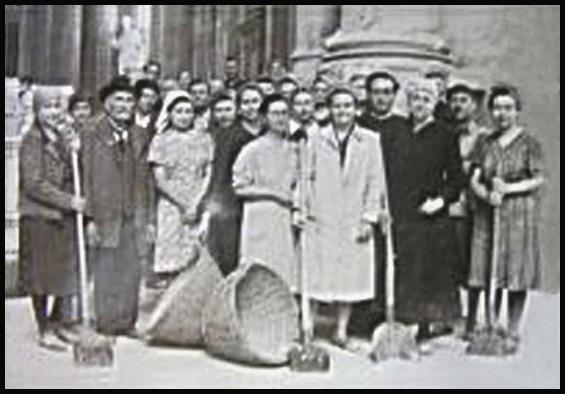
Above, a photograph of the “Cathedral Cleaners” was not dated, nor do I have any information about these “Good Souls” who kept God’s House in such immaculate order. Their tools were shovels and baskets which would indicate to us now, that their daily toils were driven by their love for the church, their strong belief in their Service to our Lord, and the immediate community around the cathedral. Hand labor filling the debris baskets and carrying them outside, speaks well of their great toils and strong faith.
The soft lighting of the image would indicate that the roof was probably now completed and the interiors were safe and stable enough to allow these “Good Souls” to work in all of the areas as necessary, and this probably would have been the period of time just before the rededication.
Any further information or additional photographs of these persons or their families, as to whom they were, or about their work, would be appreciated here. You can e-mail us at our website address on the front page – bottom of our website.
The following three images are undated, but do show a state of repairs as being completed. It is not necessarily the condition of the work as it stood at the time of rededication in 1947, but may have been much later on in the calendar, as there were always a shortages of funding, possible weather or material delays, and the progress of work being slowed during the heavy winter months. Multiple coats of plasterwork require time to dry and cure, and there were probably times of insufficient warmth of such a large cavernous space in the winter months.
I believe that these following images were taken sometime after the Consecration. I do not recall that the columns and the arches were so well finished in 1947. The fact that there is no electric organ visible in the choir would indicate that it had not arrived yet from the “States” at the time of the photographs, however, the organ box-like case at the right side could well be the second organ after reconstruction that replaced the electronic organ. It also could have been well after the dedication as there was a special “documentation” session taking place several years later and the following images were a part of that work. –Paul Kalotay
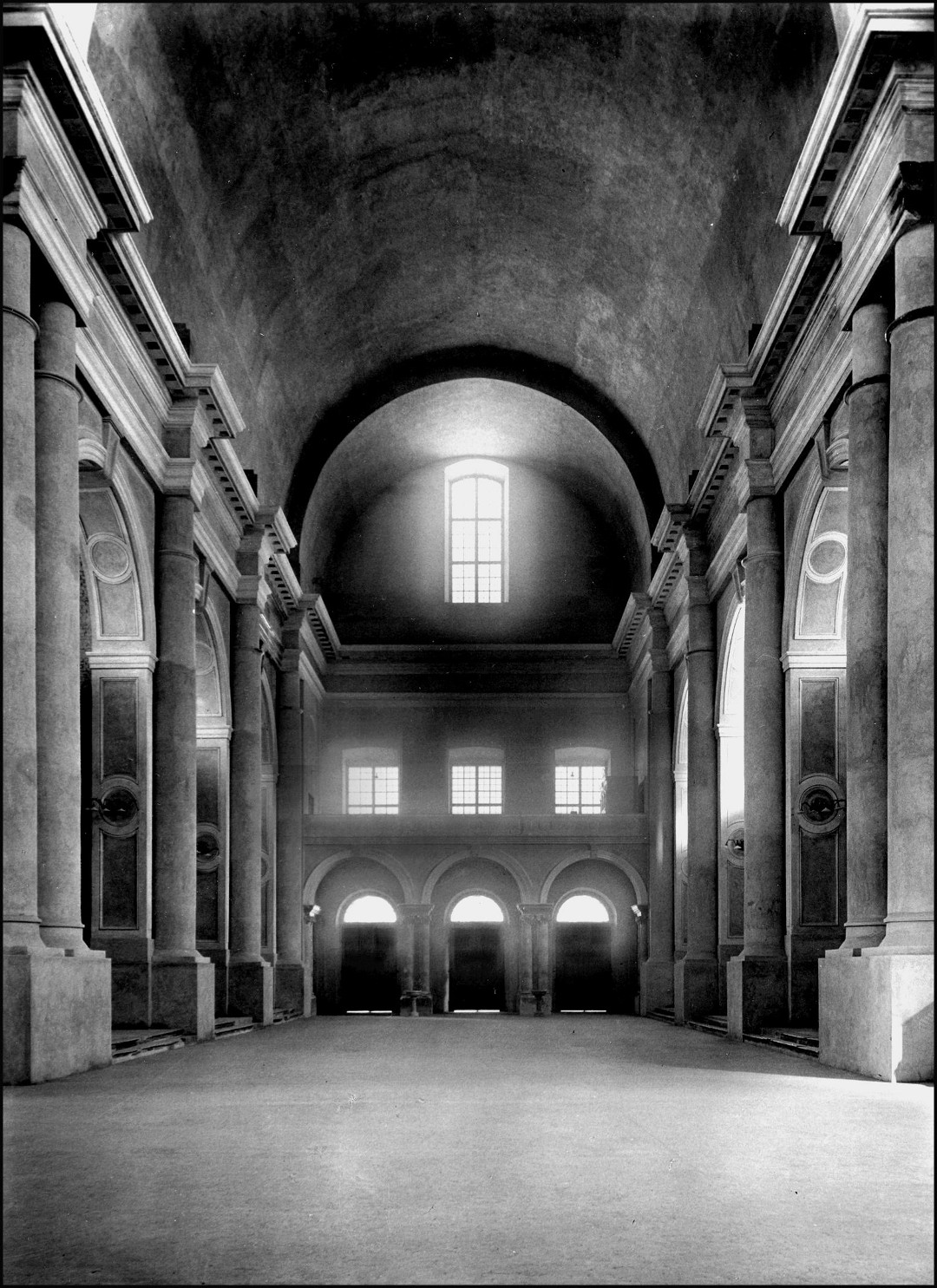
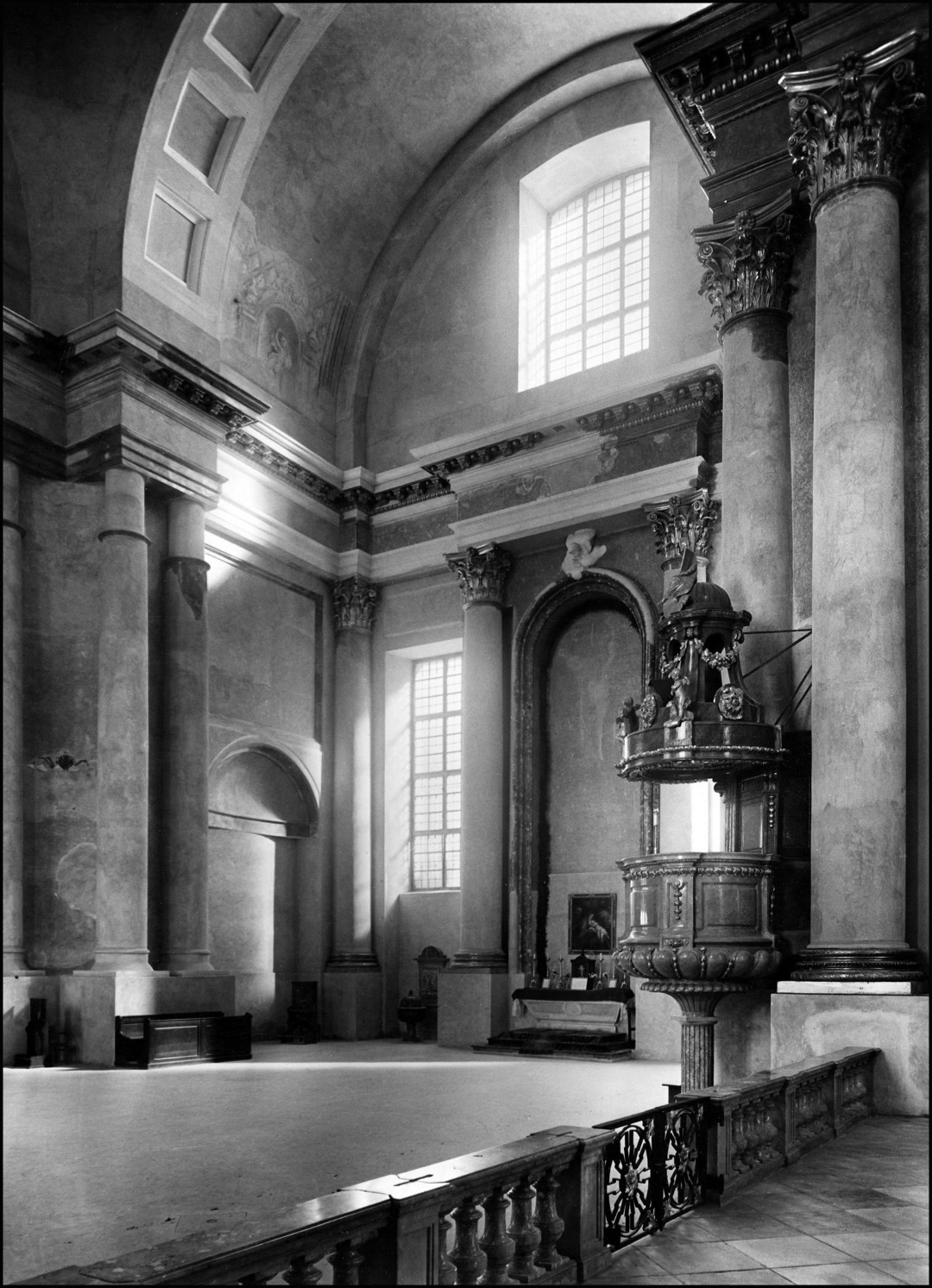
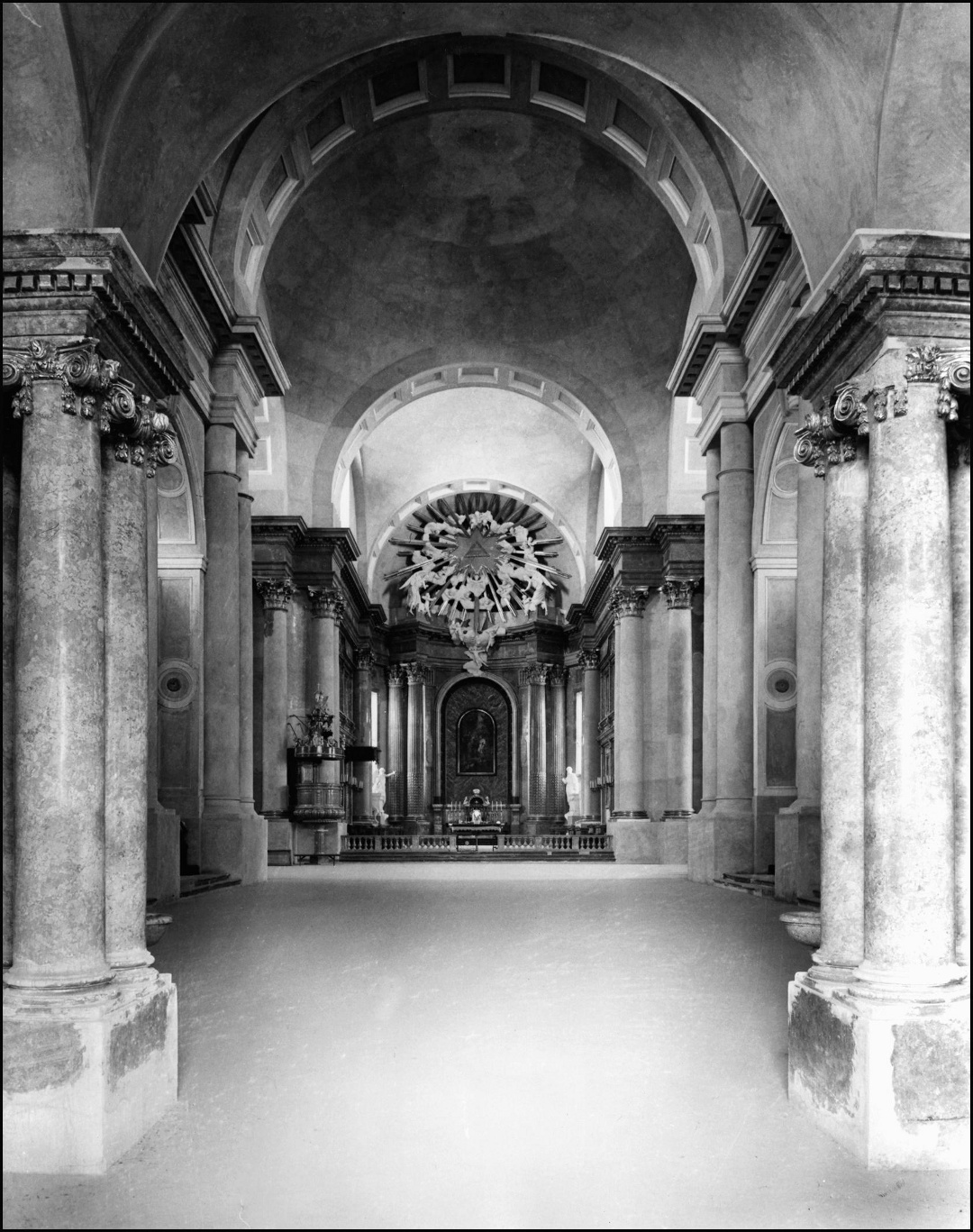
(cir. late 1950s or early 1960s)
The above three images are undated but were probably taken with a large format camera on tripod using natural light. (It would be speculation to assume that these images just above, were taken prior to or just after the Rededication of the cathedral in ‘47.) The following newspaper article however was received many years ago and may now give us some insight as to the state of the interiors. The reporter was allowed by the Bishop to enter the cathedral at some time prior to the re-dedication, where he then collected his thoughts and wrote his notes standing in the solitude of this cavernous space now waiting for its “consecration”. A state of readiness perhaps that may be illustrated by the three images just above that provoked his notes and his newspaper article that now follows:
Newspaper Articles #11
24 August 1947, Nyugati Kis Újság. pg.3
"The last rush to complete the reconstruction of the cathedral by the time of its Rededication. What will the temporary interior of the cathedral look like? In general, our mental images of cities are not panoramic views but snapshots of individual details that convey the essence of a city more powerfully than birds-eye views. When you say Paris, I think of the Eiffel Tower. When I hear the name of Rome, the mighty silhouette of St. Peter’s cathedral emerges. Mention Prague and I see the Hradzin on a hilltop. The spirit of Athens is embodied in the Acropolis. This is how world-famous cities could be photographed; and what about Szombathely now.
As a prisoner of war, in a bitter moment of homesickness it was natural that I scribbled some lines about the cathedral into my diary. It was not a coincidence. It was an instinctive act at that time, but now I understand: the city of Szombathely, whether we look at it from far or close, from past or future, zoomed in or zoomed out, is the cathedral, and the cathedral is Szombathely itself. That this is not just an idea born out of benign and vague musing, but is proved by the fact that after March 4, 1945, when the church collapsed with the horror of a Dies Irae, we are now getting ready for the feast of September 7-8, 1947.
After three years, a heroic epoch of reconstruction, the church is again standing as the symbol of unity between the city and the cathedral. In the weeks preceding the national celebrations of the rededication, many visitors of the cathedral ask whether the work can be completed in time. We asked the most competent person, the abbot Dr. Elek Sághy, who gave the following information: The scaffolds are gone and only those parts of the walls need plastering that are within easy reach. The surfaces are simple and smooth, highlighting the lines of the architecture. There are no ornaments that would distract the viewer who can now focus on the enormous size, on the harmony between columns and vaults, and on the entire magnificent structure.
The side-altars are not covered by plaster and will remain in their unornamented simplicity. Nevertheless, the altar-tables will be refurbished so that masses can be celebrated by them. The sanctuary is completed. The plastering is mildly colored in order to match it with the red marble that survived the bombing. The old benches will be put back, as well as the canonical stalls and the copper chandeliers with light bulbs, in the same order as we got used to them in the old, splendid cathedral. New lights will be installed behind the columns for lighting the altarpiece, Magnificat by Dorffmeister, on loan from the Benedictines of Kőszeg. It is smaller than the original painting, so the remaining space will be covered by drapes. The plastering and finishing of the choir is still to be done. The floor will be plain concrete; it will be covered by stone tiles at a later time. No benches will be present in the main aisle, partly in order to facilitate the attendance of the celebrations by as many people as possible, partly because the benches would be too costly. The old benches were all destroyed when the enormous ceiling collapsed.
Forty people are at intense work so that everything will be completed in time. According to the agreement, the contractor will transfer the church to the owner by the end of August, in order to have at least a week for cleaning and decorating the cathedral. The organization and work has already started in the church community centers, people are preparing paper decorations and embroidered banners, and the work intensifies as the great day is approaching, which will surely be a feast of joy for all citizens of Szombathely, catholic and others alike.” (jp)
(Mihaly Posfai for his father Jozsef Posfai) Ref: 1947. augusztus 24. Vasarnap – pg. 3 NYUGATI KIS UJSÁG
(Many more newspaper articles can be found in both Hungarian and English on this Website. Follow the link under “Newspaper Articles” to read more accounts from this period in history.)
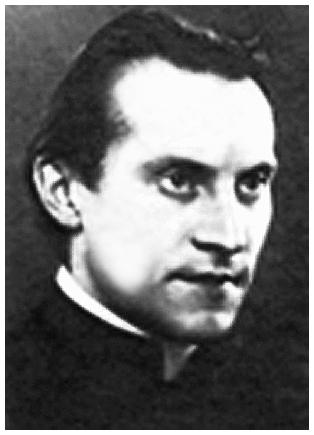
Dr. Werner Alajos, Choir Master. Born in Újkécske, Hungary in 1905 and passed in 1978 (Budapest).
Ordained a priest in Szombathely in 1928 and formed the Choir in Szombathely in 1933. The Choir was made up of men and boys that first sung in the Cathedral on December 8, 1934. Later they traveled to concerts about the country. Boys (10-11 years of age) came from the local schools in Szombathely and were tutored and trained by Dr. Werner.
He attended Pázmány Péter University (Budapest), to study music and received his degree in 1928. He then traveled to Rome five years after being ordained a priest to attend the Institute of Church Music where he studied Gregorian music and composition and received his PhD. in 1931. He returns to the Cathedral at Szombathely to teach at the Seminary (next door to the cathedral) and shortly begins the process of forming the Choir.
In 1936, he leaves for Budapest to accept a teaching appointment at the Music Academy. His duties and responsibilities in Szombathely were assumed by Mihály Radványi as the choir's second Director.
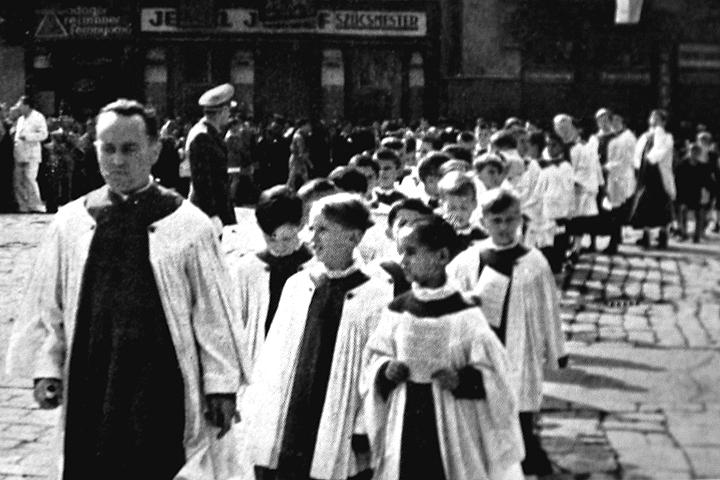
The stone pavement would indicate that the location would have been the City Square (or Főtér). The second director Dr. Radvány Mihály is leading the choir and this may have been on the occasion of the Marian Congress on the following day - Monday, September 8, 1947. Shadow lines on the pavement would indicate early afternoon.
The store front sign above the choir Jesztl József, Szűcs-mester, Szentháromság (Holy Trinity Square) tér 9, (from a 1943 telephone book).
The szűcs-mester (furrier) in question was Jesztl József. His store was on the Főtér, on the west side, right behind the Holy Trinity Statue. The Primate’s Altar was in front of this statue on the east side of the Holy Trinity Statue on the following day at the Marian Celebrations. –Paul Kalotay
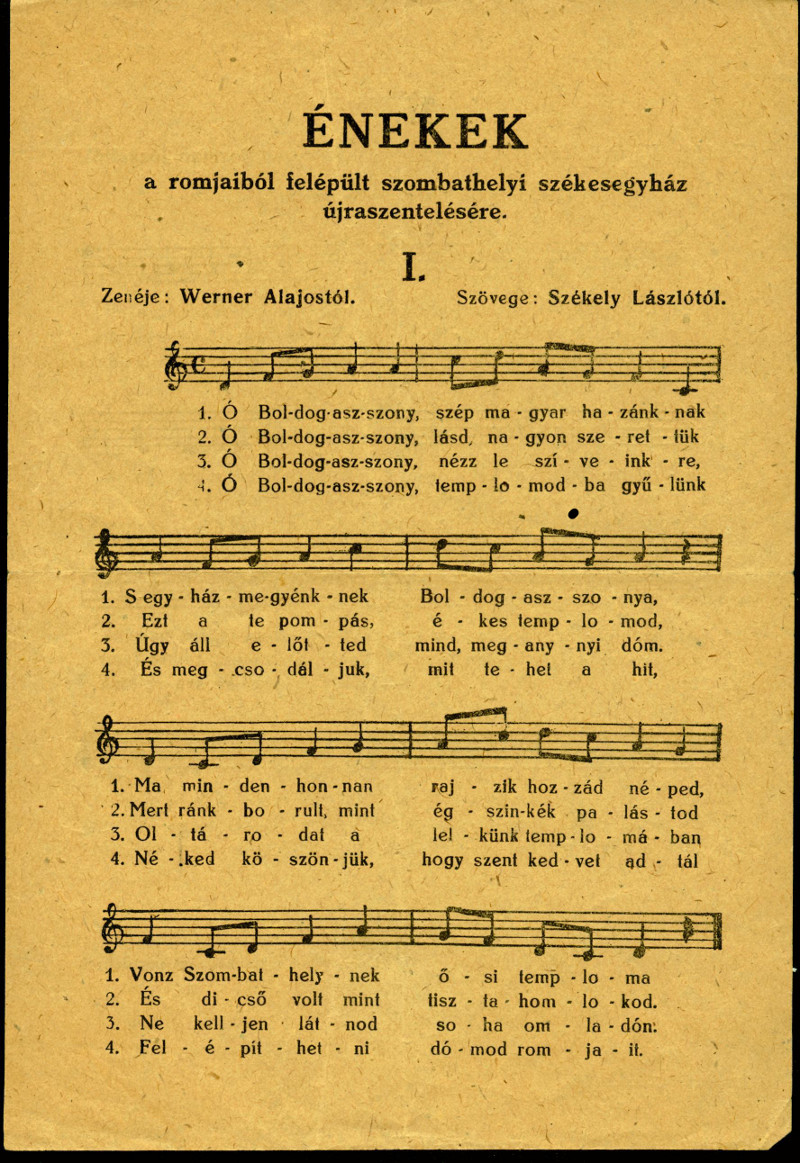
Given in the cathedral on September 7, 1947 following the reconsecration.
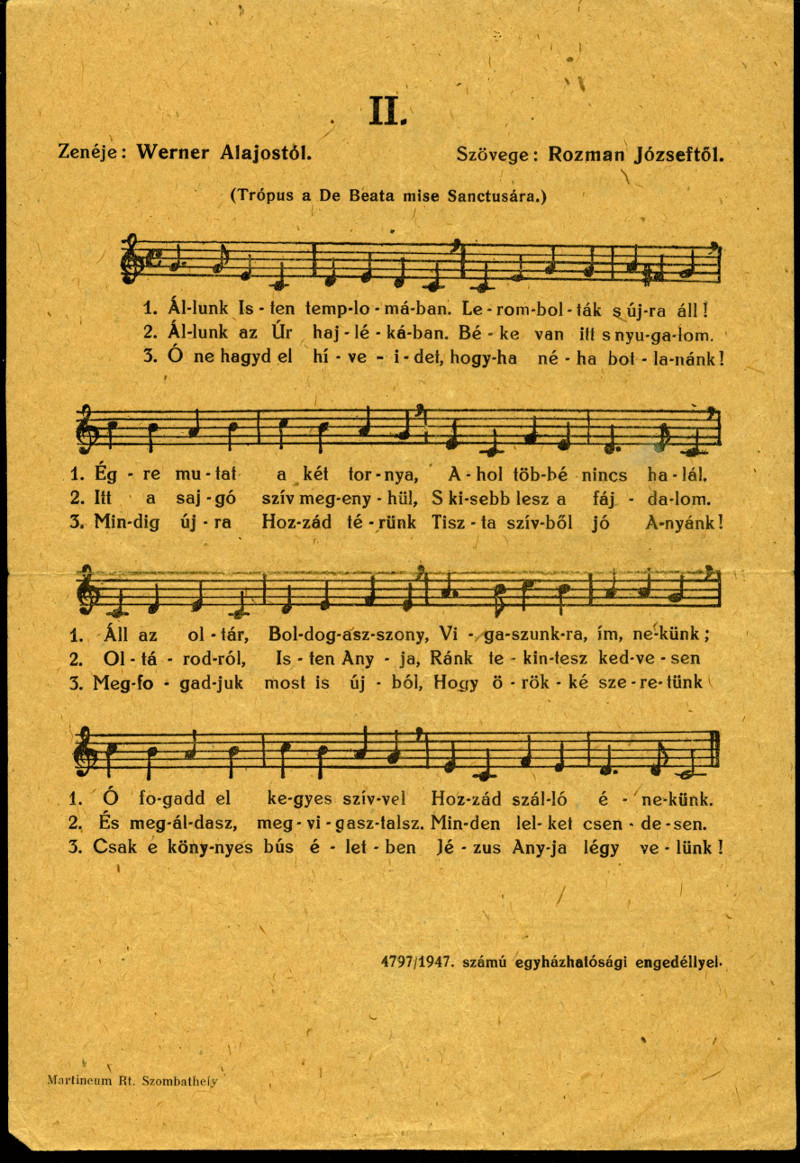
The reverse side II of the first image. Printed by Martineum Press Rt, Szombathely 1947. Print Order #4797.
Original music from the afternoon concert that was given in the Cathedral on September 7, 1947. (following the rededication.) “In praise of the Art of Song: ..Five choirs from the area of the Diocese came to the newly dedicated cathedral to enrich the souls with their religious, artful song. (Sunday afternoon). On this day of joy and mirth - as Alajos Werner said - they wanted to present a bouquet laced with thankful melodies, exalted rhythms, a harmony of sounds and hearts - to compensate for all the tears, to secure smiles for the future, but mostly, for thanking the Holy Mother for giving us willingness to rebuild Her temple from the ruins. On this very afternoon of the re-dedication, in the presence of Cardinal Mindszenty and his fellow priests, for two hours the souls of three thousand faithful rose towards God on the wings of prayer-songs. The foreword for the concert was given from the pulpit by Dr. Alajos Werner, the professor of the Music Academy, with the following thoughtful meditation:
Human history - he reflected - started with the ruins of the lost Paradise and its way continues through these ruins. But humanity was given singing prophets, who could not accept such ruins, but proclaimed with the Psalmist (Psalm 108:2*): 'Wake up, zither, and harp, I want to tint the dawn with my song' - and they recalled the old melodies from the lost Paradise, and composed new songs about the Paradise to be re-gained. (*107 in original).
What was the star that always kept kindling and calling them, and did not allow their lutes to fade and their songs to get tired? God lit up above the ruins a star: ‘Stella Matutina’, the portrait of the Virgin Mary. And ever since then, the Christian faithful surrounded this star with every form of art: Paintings, sculptures, poetry and architecture, but mostly with the language of the heart and soaring spirit: ‘Music’...
...Before there were any churches dedicated to Her (the first one was built in 363 AD), before there were any Marian holy days (the first one was in Syria cir. 380 AD), on the example of St. Ephraim (who died in 373 AD), Christians already were praising the Virgin Mother every day, on every hour. At the birth of Christianity, the Church was already singing about Mary, as the ‘Star of the Sea’, ‘Portal of Heaven’, and ‘Priceless Flower of Heaven’.
Maybe it is not a coincidence that in the musical history of Hungary, the first song with notation is about the Holy Virgin; the song of the Franciscan friar András Vásárhelyi: ‘Mother of the Holy Angels’ which was preserved for posterity on the Codex of Nador in (1508). Many years before the Turkish-Tartar ruins and even before the conversion of the faith, the praise to the Holy Virgin was ingrained in the Hungarian heart and soul.
In the centuries that followed, these hymns about Mary resounded across Hungary that was in ruins - either in the hearts of some of the people, or through the entire history of the Nation: these songs about the Virgin Mary were a balm for our aching hearts. Oh, how many times did the Virgin sing into our hearts, into the conscience of the Nation, to the entire history of mankind!
In the deep abyss of darkness, in the starless nights and lost trails, when dark thoughts tempted us, out of the depths of our souls or from faraway angels lips sprang up the Ave Maria, Salve Regina, Ave ‘Maria Stella’, our Mother in Heaven, or the Stretch out to us, Oh Holy Mother, thy Hand. And the sounds, that called back to the lost Paradise, once more showed the way, and from the ruins they vaulted us again into new life."
(Above excerpt about Dr. Mihály Radvány is from Toronyi Németh István's Book.)
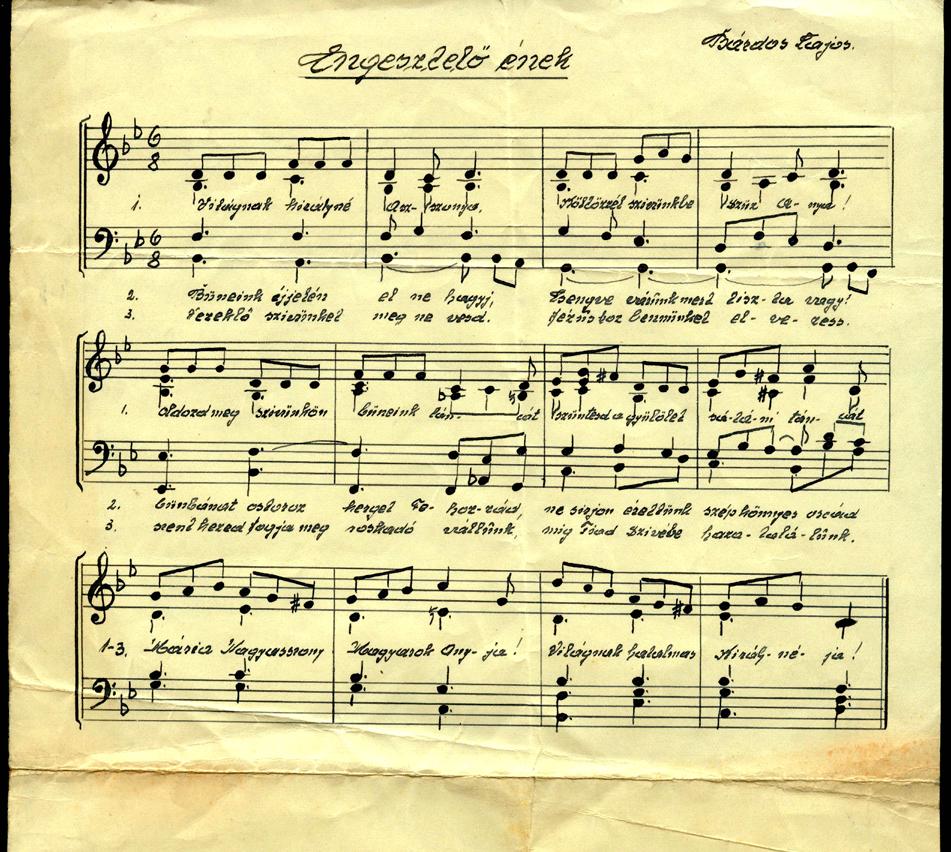
Also written or copied by hand using pen and ink by Dr. Werner Alajos. Item was found with music #23 and #24 previously.
"...Now, in this concert to the Holy Virgin, the fine choirs of Szombathely and its diocese, in the name of all of us and in Thanks- giving, will present to us those churches and chapels dedicated to Mary, which for over centuries were built with a living faith, filling hearts and joyful souls. Bombs could not destroy these living, singing churches, and even in time cannot diminish their beauty or brilliance, because every day they are rebuilt in the soaring souls and hearts of their singers.
...There were five mixed choirs in this program of the afternoon. The Cecilia choir from the diocese of Szombathely, Boldizsár Horváth, conductor; the choir from the parish of Kőszeg, János Szabó, conductor; the choir from the parish of Zalaegerszeg, Ferenc Vargha, conducting; the Salesian choir and orchestra from Szombathely, Mihály Schmidt, conducting; and the ensemble Scola Cantorum Sabariensis, Dr. Mihály Radvány, conducting.
...The choirs presented the jewels of the sacred songs - in the works of Liszt, Kodály, Bárdos, Werner, Harmat, Deák and Szabó, the choirs showed us the beauty of the Hungarian sacred music; and through the works of Victoria, Lassus, Viadana, Pagella, Josquin and Schubert, the choirs showed us the rich world of polyphony from foreign lands
...This joint concert of the participating choirs was made unforgettable by the rendition of the ancient Marian song: "Our Holy Mother" in the arrangement by Artur Harmat and conducted by the composer himself Everyone was deeply moved; it brought penitence, pleading, trust into the hearts, and for a long time afterwards the words were echoed in the minds of the departing crowd: ‘Do not forget our forsaken Nation and its long-suffering people!’ ” (Toronyi Németh István).
*Attention: Translators are always welcomed, such as the photo pages above. If you can volunteer with English/Hungarian translations, please contact us at: march4_1945project@earthlink.net